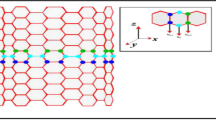Abstract
The possibility of existence of electromagnetic solitons is explored based on the coupled equations for the classical function of electron distribution in carbon nanotubes and the Maxwell equations for the electromagnetic field. The solitons emerge due to a concerted change in the classical distribution function and the electric field generated by the nonequilibrium electrons of a carbon nanotube. An efficient equation was obtained to describe the electromagnetic-field dynamics. The data of numerical calculations indicating the existence of solitons are given.
Similar content being viewed by others
References
G. B. Sergeyev, Nanochemistry [in Russian], M. V. Lomonosov Moscow State University (2003).
M. C. Roko, P. S. Williams, and P. Alivisatos (eds), Nanotechnology Research Directions. IWQN Workshop Report: Vision for Nanotechnology in the Next Decade, Kluwer Academic (2000).
S. A. Maksimenko and G. Ya. Slepyan, “Nanoelectromagnetics of low-dimensional structure,” in: A. Lakhtakia (ed.), Handbook of Nanotechnology. Nanometer Structure: Theory, Modeling, and Simulation, SPIE Press, Bellingham (2004).
Hyatt M. Gibbs, Optical Bistability: Controlling Light with Light, Academic Press, Orlando (1985).
G. Ya. Slepyan, S. A. Maksimenko, V. P. Kalosha, et al., Phys. Rev. A, 60, R777 (1999).
M. F. Lin and K. W.-K. Shung, Phys. Rev. B, 50, 17744 (1994).
R. Saito, M. Fujita, G. Dresselhaus, and M. S. Dresselhaus, Phys. Rev. B, 46, 1804 (1992).
P. R. Wallace, Phys. Rev., 71, 622 (1947).
L. D. Landau and E. M. Lifshitz, Field Theory [in Russian], Fizmatlit, Noscow (1988).
L. D. Landau and E. M. Lifshitz, Physical Kinetics [in Russian], Nauka, Mosccow (1979).
S. J. Tans, M. H. Devoret, H. Dai, et al., Nature, 386, 474 (1997).
F. G. Bass, A. A. Bulgakov, and A. P. Tetervov, High-Frequency Properties of Semiconductors with Superlattices [in Russian], Nauka, Moscow (1989).
E. M. Epshtein, Fiz. Tverd. Tela, 19, 3456–3458 (1977).
R. Bulla-and F. Codry (eds.), Solitons [Russian translation], Mir, Moscow (1983).
P. W. Kitchenside, P. J. Caudrey, and R. K. Bullough, Phys. Scripta, 20, 673 (1979).
K. A. Gorshkov, L. A. Ostrovsky, and V. V. Papko, Zh. Éksp. Teor. Fiz., 71, 585 (1976).
Author information
Authors and Affiliations
Additional information
__________
Translated from a manuscript submitted on July 4, 2006.
Rights and permissions
About this article
Cite this article
Belonenko, M.B., Demushkina, E.V. & Lebedev, N.G. Electromagnetic solitons in a system of carbon nanotubes. J Russ Laser Res 27, 457–465 (2006). https://doi.org/10.1007/s10946-006-0027-7
Issue Date:
DOI: https://doi.org/10.1007/s10946-006-0027-7



